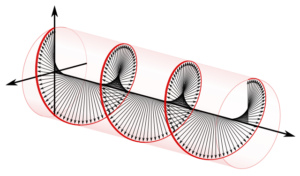7.5 polarization, helical beam, parabolic antennas

Exploring Polarization, Helical Beam, and Parabolic Antennas
Delving into Advanced Antenna Concepts The field of amateur radio is replete with diverse and complex technologies, among which antennas play a pivotal role. This chapter, titled “Polarization, Helical Beam, and Parabolic Antennas,” delves into some of the more advanced aspects of antenna theory and practice. Understanding these concepts is crucial for amateur radio operators looking to enhance their skills and capabilities, particularly those aiming for an Advanced Licence qualification in Canada. The chapter covers the intricacies of different polarizations, the unique properties of helical beam antennas, and the efficiency and design considerations of parabolic antennas.
Polarization: A Key to Effective Communication Polarization, whether circular, vertical, or horizontal, is a fundamental property of electromagnetic waves that can significantly impact the efficiency of signal transmission and reception. The chapter examines how different antenna designs, such as crossed dipoles and helical antennas, achieve various polarization modes. This knowledge is essential for applications ranging from satellite communication to terrestrial point-to-point links.
Helical and Parabolic Antennas: Advanced Designs for Specific Needs The chapter also explores the characteristics and applications of helical beam and parabolic antennas. Helical antennas, known for their versatility in polarization, are discussed in terms of their design parameters and reception capabilities. Parabolic antennas, with their high-gain characteristics, are dissected to understand how their size and shape influence their performance. These discussions are particularly relevant for amateur radio operators interested in long-distance communication and satellite operations.
